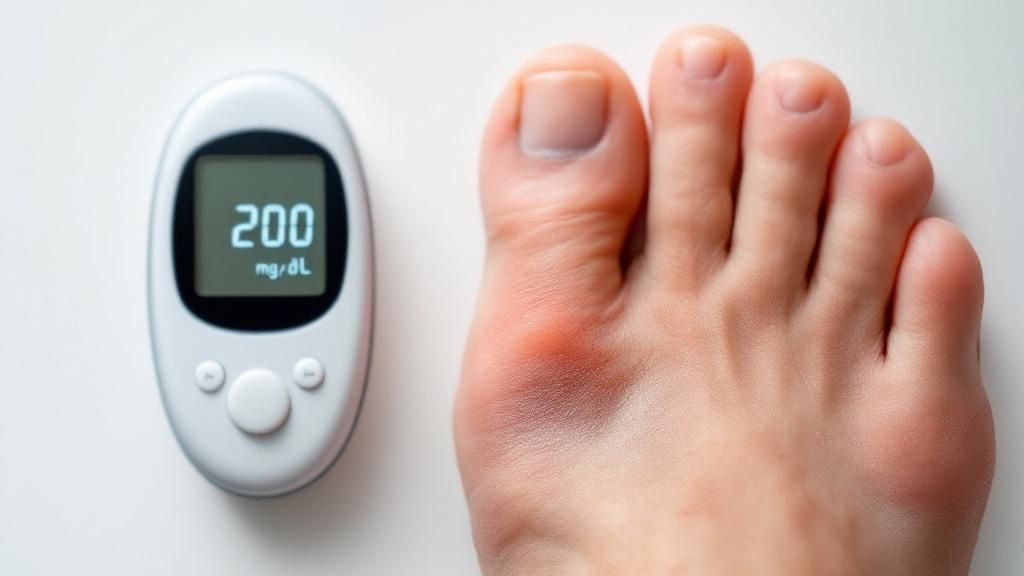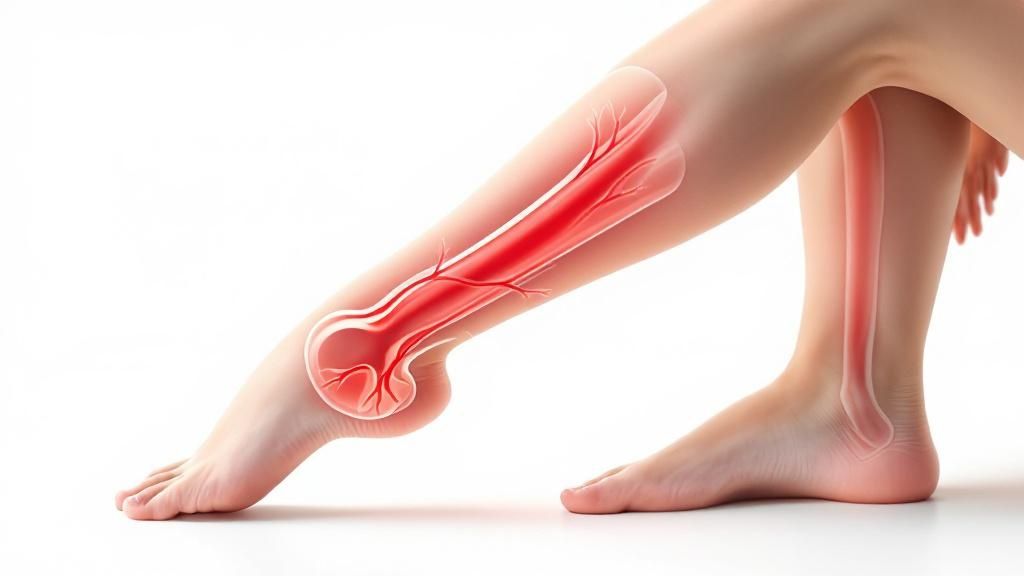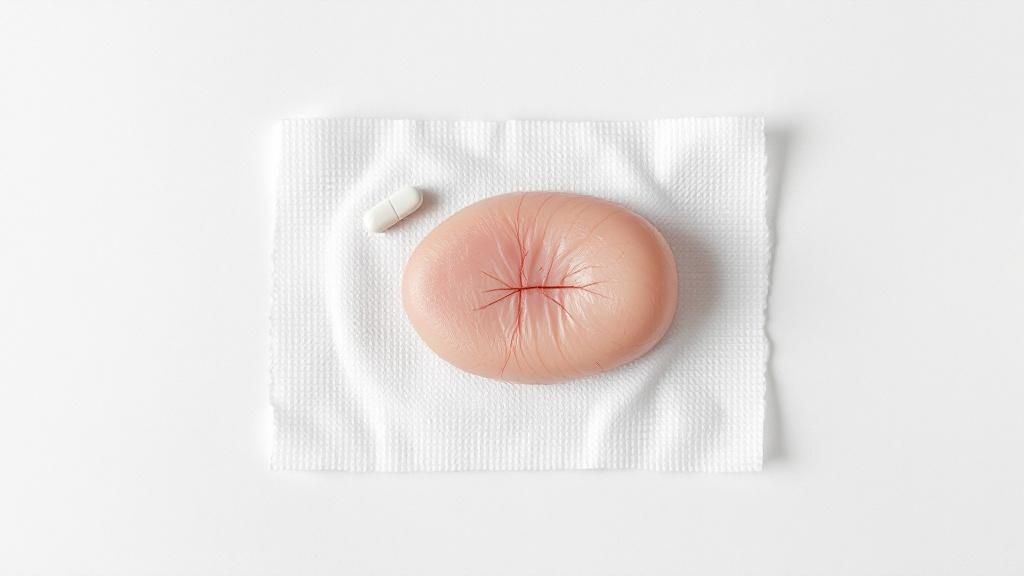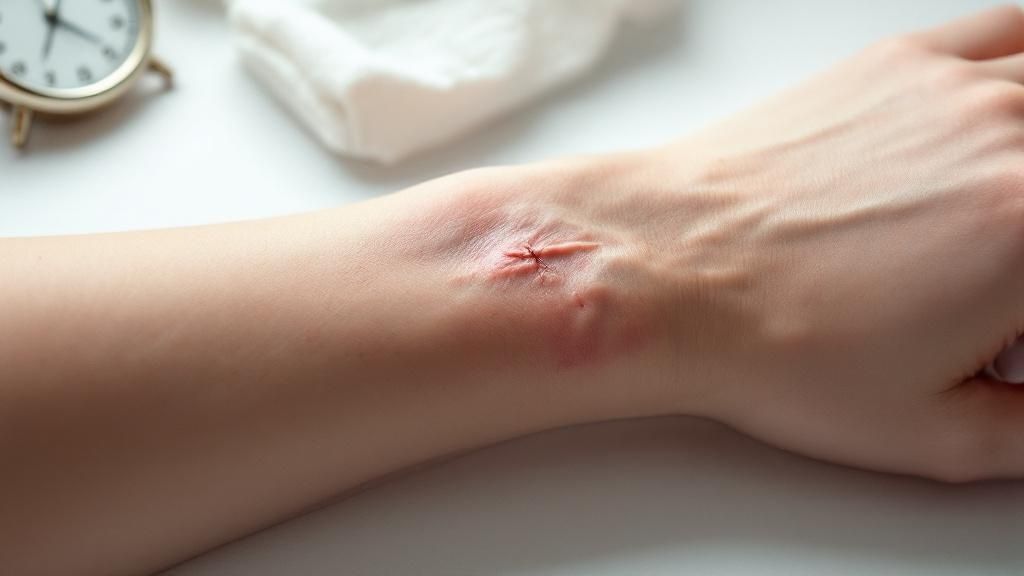Understanding Why Wounds Won't Heal
A wound that refuses to heal can be a serious concern. This article identifies six common delayed wound healing causes, providing valuable insights for patients and healthcare providers alike. Understanding these causes is crucial for effective treatment and faster recovery. We'll cover how factors like diabetes, infection, poor circulation, nutritional deficiencies, medications, and age can significantly impact wound healing. This knowledge empowers you to address these issues and promote healing.
1. Diabetes and Hyperglycemia
Diabetes and persistently elevated blood glucose levels (hyperglycemia) represent a significant impediment to timely wound healing. This condition earns its place at the top of the list of delayed wound healing causes due to its widespread prevalence and the profound impact it has on multiple physiological processes crucial for tissue repair. High blood sugar creates a cascade of negative effects that compromise the body's natural ability to heal, affecting everything from the initial blood clotting phase to the final stages of scar formation. This makes diabetes a critical consideration for anyone experiencing slow-healing wounds.

The detrimental effects of diabetes on wound healing stem from several key features:
-
Impaired Immune Response: High blood sugar levels weaken the immune system, specifically impairing the function of white blood cells that are essential for fighting infection. This increased susceptibility to infection significantly delays wound healing and can lead to serious complications.
-
Reduced Collagen Synthesis: Collagen is the primary structural protein in skin and other connective tissues. Hyperglycemia directly interferes with collagen production, resulting in weaker, less resilient tissue that is prone to breakdown and slow to repair. This poor tissue regeneration makes it difficult for the wound to close efficiently.
-
Compromised Blood Flow: Diabetes often leads to microvascular damage, affecting the small blood vessels that supply oxygen and nutrients to tissues. This reduced blood flow starves the wound bed, hindering the delivery of essential components needed for healing and making the tissue more vulnerable to further damage.
-
Neuropathy and Decreased Sensation: Diabetic neuropathy, nerve damage caused by prolonged high blood sugar, can lead to reduced sensation in the extremities. This means individuals may not notice minor injuries, allowing them to progress unnoticed and become infected before treatment is sought. Delayed injury recognition is a major contributing factor to chronic wound development in diabetic patients.
-
Advanced Glycation End Products (AGEs): AGEs are harmful compounds formed when excess glucose binds to proteins. These AGEs accumulate in tissues, interfering with normal cellular function and hindering the healing process. They contribute to inflammation, oxidative stress, and reduced tissue elasticity, all of which negatively impact wound closure.
While the challenges posed by diabetes to wound healing are significant, the mechanisms are well-understood, allowing for targeted treatment approaches. Effective blood sugar control is paramount in improving healing outcomes. Multiple treatment modalities are available, including medication, lifestyle modifications, and specialized wound care products.
Pros of understanding the diabetic impact on wound healing:
- Targeted treatment approaches are possible due to the well-understood mechanisms.
- Blood sugar control can significantly improve healing outcomes.
- Multiple treatment modalities are available to address the various aspects of impaired healing.
Cons of managing diabetic wounds:
- Often requires long-term management and significant lifestyle changes.
- Can lead to severe complications like amputation if left untreated.
- Healing times can be significantly extended, often 2-4 times longer than in non-diabetic individuals.
Examples of the impact of diabetes on wound healing are readily apparent: diabetic foot ulcers affect approximately 15% of diabetic patients; surgical site infections occur 2-3 times more frequently in diabetic patients; and chronic leg ulcers are a common complication in those with poorly controlled diabetes. Learn more about Diabetes and Hyperglycemia and how it specifically impacts diabetic foot ulcers.
Tips for managing wounds in diabetic patients:
- Maintain optimal HbA1c levels: Strive to keep HbA1c levels below 7% as advised by your physician to minimize the long-term effects of high blood sugar.
- Regular wound monitoring: Inspect wounds daily for any signs of infection, such as increased redness, swelling, pain, or drainage.
- Specialized wound care: Utilize specialized diabetic wound care products designed to promote healing in the presence of impaired circulation and reduced immune function.
- Nutritional support: Ensure adequate protein intake to support tissue repair and collagen synthesis.
- Collaborative care: Work closely with endocrinologists and other healthcare professionals for optimal glucose management and comprehensive wound care.
By understanding the multifaceted ways diabetes influences wound healing, patients and healthcare providers can take proactive steps to mitigate risks, promote faster healing, and prevent serious complications.
2. Infection and Bacterial Contamination
One of the most significant impediments to delayed wound healing is infection and bacterial contamination. A wound, essentially a break in the skin's protective barrier, becomes a vulnerable entry point for various microorganisms, particularly bacteria. These pathogens can thrive in the wound environment, consuming oxygen and nutrients vital for tissue repair. Furthermore, they produce harmful toxins that damage healthy surrounding tissue, exacerbating the injury and significantly hindering the natural healing process. This detrimental effect on wound healing stems from the disruption of the intricate cascade of events that normally lead to tissue regeneration.

Infection triggers a prolonged inflammatory response, which, while a crucial initial step in healing, becomes detrimental when persistent. Instead of transitioning smoothly to the proliferative phase, where new tissue forms, the wound remains stuck in a chronic inflammatory state. This prevents the formation of new blood vessels, the migration of fibroblasts (cells responsible for collagen production), and ultimately, the remodeling of the wound into healthy scar tissue. The longer a wound remains infected, the more complex and protracted the healing process becomes, potentially leading to chronic wounds. This is particularly problematic for individuals with underlying health conditions like diabetes or compromised immune systems, where even minor infections can have serious consequences.
Bacterial contamination in wounds can manifest in several ways, including the formation of biofilms. These biofilms are complex communities of bacteria encased in a protective matrix, making them highly resistant to both the body's natural defenses and conventional antibiotic therapies. The presence of a biofilm further contributes to the chronicity of the infection and the delayed wound healing process. Different bacterial species can cause varying degrees of wound infection. For instance, Methicillin-resistant Staphylococcus aureus (MRSA) infections in surgical wounds often require specialized antibiotics, while Pseudomonas aeruginosa infections in burn patients can cause a characteristic blue-green discoloration and significant tissue damage. Chronic wounds may become colonized by multiple antibiotic-resistant organisms, posing a considerable therapeutic challenge.
Infection and bacterial contamination undeniably deserve a prominent place on the list of delayed wound healing causes. The prolonged inflammatory response, coupled with the potential for biofilm formation and tissue destruction, significantly impairs the body's ability to repair damaged tissues. Understanding the mechanisms by which bacteria hinder wound healing is crucial for developing effective prevention and treatment strategies.
While bacterial contamination poses a considerable threat to wound healing, it is often preventable with meticulous wound care and hygiene. Practicing proper handwashing, using sterile dressings, and keeping the wound clean and dry are essential steps in preventing infection. Early detection and prompt treatment are also critical. Signs of infection include increased pain, redness, swelling, warmth around the wound, and the presence of purulent (pus-like) drainage. If any of these signs are present, it's crucial to seek medical attention immediately.
Here are some actionable tips to prevent and manage wound infections:
- Maintain sterile technique during wound care procedures: This includes washing hands thoroughly before and after dressing changes and using sterile gloves and dressings.
- Monitor for signs of infection: Be vigilant for increased pain, redness, warmth, swelling, and purulent drainage.
- Obtain wound cultures before starting antibiotic therapy: This helps identify the specific bacteria causing the infection and guides appropriate antibiotic selection.
- Consider topical antimicrobials for localized infections: Topical agents can deliver high concentrations of antibiotics directly to the wound site.
- Ensure adequate debridement of necrotic tissue: Removing dead and damaged tissue creates a cleaner wound environment less hospitable to bacterial growth.
Early diagnosis and intervention significantly improve the prognosis for infected wounds. Appropriate antibiotic therapy is often successful in eradicating the infection and allowing the wound to progress through the healing phases. However, the rise of antibiotic resistance necessitates careful antibiotic stewardship and the exploration of alternative treatment strategies. In some cases, surgical debridement or drainage procedures may be required to remove infected tissue and promote healing. While infection can be a severe complication, its often preventable nature and the availability of effective treatments highlight the importance of proactive wound management and prompt medical care.
3. Poor Blood Circulation and Vascular Disease
Poor blood circulation and vascular disease are significant contributors to delayed wound healing, earning their place on this list due to their profound impact on the body's natural repair mechanisms. Adequate blood flow is the cornerstone of efficient wound healing. It acts as the delivery system, transporting vital oxygen and nutrients to the wound site, fueling the energy-intensive process of tissue repair. Simultaneously, blood flow carries away metabolic waste products and toxins that accumulate at the injury site and hinder healing. It also acts as the highway for immune cells and growth factors, essential components in fighting infection and stimulating new tissue growth. When blood flow is compromised, this intricate system breaks down, significantly impeding the healing process and potentially leading to chronic, non-healing wounds. This is particularly crucial for understanding delayed wound healing causes.

Several vascular conditions can contribute to this problem. Peripheral arterial disease (PAD) narrows the arteries, restricting blood flow to the extremities, particularly the legs and feet. Venous insufficiency, on the other hand, affects the veins, hindering the return of blood from the extremities to the heart. This can lead to pooling of blood and swelling, further compromising circulation. Microvascular complications, affecting the smallest blood vessels, can also disrupt the delicate balance of oxygen and nutrient delivery and waste removal.
The consequences of impaired circulation on wound healing are multifaceted. Reduced oxygen and nutrient delivery starves the tissues, hindering cell growth and repair. The impaired removal of metabolic waste and toxins creates a toxic environment that further inhibits healing. Furthermore, the delivery of crucial immune cells and growth factors is diminished, increasing the risk of infection and slowing down tissue regeneration. This poor tissue perfusion can ultimately lead to tissue death and the formation of chronic ulcers, particularly in the extremities. You can Learn more about Poor Blood Circulation and Vascular Disease.
While the implications of vascular disease on wound healing can be serious, there are both diagnostic and treatment options available. Non-invasive diagnostic tools, such as ankle-brachial index (ABI) testing, can readily assess vascular status. This simple test compares the blood pressure in your ankle to the blood pressure in your arm to determine the degree of arterial narrowing.
Treatment approaches range from conservative measures to surgical interventions. Optimizing positioning, for instance, can improve circulation by elevating the legs to promote venous return. Compression therapy, using specialized bandages or stockings, can be particularly effective for venous disease, helping to reduce swelling and improve blood flow. For severe cases, hyperbaric oxygen therapy, which involves breathing pure oxygen in a pressurized chamber, can significantly increase oxygen delivery to the wound tissues. Addressing underlying cardiovascular risk factors, such as smoking, high blood pressure, and diabetes, is crucial for managing the progression of vascular disease and preventing recurrent wound healing problems.
Vascular interventions, such as angioplasty or bypass surgery, can dramatically improve healing outcomes in more advanced cases. Angioplasty involves using a small balloon to open narrowed arteries, while bypass surgery creates a detour around blocked arteries to restore blood flow. These procedures can be life-changing for patients with chronic, non-healing wounds caused by severe vascular disease.
However, it's important to acknowledge the potential drawbacks. Surgical interventions are invasive and carry inherent risks. Vascular disease is often associated with other serious cardiovascular comorbidities that require careful management. Furthermore, the progressive nature of vascular disease can lead to recurrent problems, necessitating ongoing monitoring and treatment. For example, arterial ulcers on the toes and feet are a common manifestation of PAD, while venous stasis ulcers typically occur around the ankles in patients with chronic venous insufficiency. Pressure ulcers can also develop in patients with compromised circulation due to prolonged immobility.
Despite the challenges, understanding the crucial role of blood circulation in wound healing is paramount. Early diagnosis, appropriate management of vascular disease, and proactive interventions can significantly improve healing outcomes and enhance the quality of life for individuals struggling with chronic wounds. By optimizing blood flow, we can support the body's natural ability to repair and regenerate, ultimately paving the way for successful wound healing.
4. Nutritional Deficiencies
Nutritional deficiencies play a significant role in delayed wound healing, making them a critical factor to consider when addressing persistent wounds. Proper nutrition provides the building blocks necessary for tissue repair and regeneration. The body requires increased amounts of protein, vitamins, minerals, and calories during the healing process. When these nutritional needs are not met, whether due to inadequate intake, problems with absorption, or increased metabolic demands, all phases of wound healing are significantly impaired, and the risk of infection rises dramatically. This is why addressing nutritional deficiencies is crucial for promoting effective and timely wound closure. This is especially true for those suffering from chronic wounds, as the prolonged healing process places an even greater demand on the body's nutritional reserves. Failing to address these needs can lead to a cycle of stalled healing and increased susceptibility to complications.

Several key physiological processes are hampered by nutritional deficiencies, contributing to delayed wound healing. Protein synthesis, essential for building and repairing tissues as well as supporting immune function, is diminished. Collagen formation, which provides structural integrity and tensile strength to the wound, is impaired. The immune system’s ability to fight off infection is weakened, making the wound more vulnerable to complications. Cellular energy metabolism, the engine driving all healing processes, is compromised. Finally, angiogenesis, the formation of new blood vessels that supply oxygen and nutrients to the healing tissue, and overall tissue regeneration are significantly delayed. These combined effects create a challenging environment for effective wound healing.
Examples of nutritional deficiencies impacting wound healing are readily apparent in various patient populations. Protein-energy malnutrition, often seen in elderly patients with chronic wounds, contributes to slow healing and increased infection rates. Vitamin C deficiency, historically known as scurvy, impairs collagen synthesis, leading to fragile tissues and poor wound closure. Zinc deficiency hinders epithelialization, the process of new skin cell formation that closes the wound surface, and also compromises immune function. These examples highlight the wide-ranging impact of inadequate nutrition on wound healing outcomes.
Assessing and addressing nutritional deficiencies is crucial for effective wound management. Fortunately, nutritional status is relatively easy to assess through laboratory studies measuring markers like albumin, prealbumin, and transferrin levels, combined with a thorough clinical evaluation. Nutritional interventions can often lead to rapid improvements in wound healing. This makes nutritional support a cost-effective intervention compared to other, more complex treatments. Learn more about Nutritional Deficiencies and the potential benefits of home healthcare in managing these deficiencies.
While nutritional interventions offer substantial benefits, they also present some challenges. Some patients may require specialized nutritional support or supplements, increasing the complexity of care. Underlying conditions contributing to malnutrition, such as gastrointestinal disorders or metabolic diseases, can be difficult to treat and may require ongoing management. Furthermore, the lingering effects of nutritional deficiency may persist even after correction, necessitating continued monitoring and support.
To optimize wound healing through nutrition, healthcare professionals recommend ensuring adequate protein intake, often in the range of 1.2-1.5 grams per kilogram of body weight for individuals with wounds. Supplementing with vitamin C (500-1000mg daily) and zinc (15-30mg daily) can further support collagen synthesis and immune function. In some cases, specialized wound healing nutrition formulas may be beneficial. Involving registered dietitians in care planning is crucial for individualized nutritional assessments and interventions, ensuring that patients receive the targeted support they need to promote optimal wound healing. Addressing nutritional deficiencies is a fundamental aspect of comprehensive wound care, contributing significantly to improved healing outcomes and reducing the risk of complications. This is particularly relevant for "delayed wound healing causes" as it directly addresses the body's fundamental needs for repair and regeneration.
5. Medications and Drug Effects
Delayed wound healing can be a frustrating and concerning experience, especially when the underlying cause is difficult to pinpoint. One often overlooked factor contributing to delayed wound healing is the impact of medications and drug effects. Many commonly prescribed and over-the-counter medications can significantly impair the body's natural healing processes, making it crucial to understand these potential effects to optimize wound care. This is particularly relevant for individuals managing chronic conditions often requiring multiple medications, a population susceptible to delayed wound healing. Thus, "Medications and Drug Effects" rightfully earns its place on the list of delayed wound healing causes.
Medications can interfere with wound healing through a variety of mechanisms, including immune suppression, interference with cellular processes vital for tissue repair, and disruption of the normal inflammatory responses crucial for initiating the healing cascade. These disruptions can manifest in various ways, hindering the body’s ability to efficiently mend damaged tissues. For example, immune system suppression reduces the body’s resistance to infection, a common complication in delayed healing. Other medications interfere with cellular division and protein synthesis, essential processes for building new tissue. Still others disrupt the normal inflammatory and healing cascades, delaying or even halting the progression of wound repair. Furthermore, some medications can alter blood clotting and hemostasis, leading to prolonged bleeding or excessive clotting, both of which impede healing. Finally, certain drugs can reduce angiogenesis, the formation of new blood vessels, which is essential for delivering oxygen and nutrients to the healing wound, and inhibit tissue formation itself.
Several medication classes are known to affect wound healing. Corticosteroids, commonly used to suppress inflammation in conditions like autoimmune diseases and after organ transplants, can significantly delay surgical wound healing in these patients. Chemotherapy agents, essential for cancer treatment, often lead to poor healing of mucositis (inflammation of the mucous membranes) and skin breakdown, increasing the risk of infection. Anticoagulants, vital for preventing blood clots, can cause prolonged bleeding and hematoma formation at surgical sites, impeding wound closure and increasing the risk of complications.
While the potential negative impacts of medications on wound healing are considerable, it's important to highlight that these effects are often reversible with careful medication adjustment. Healthcare providers can proactively manage medication-related healing issues by carefully evaluating a patient’s medication list and considering potential interactions and effects on wound healing. In some cases, alternative medications with fewer wound healing effects may be available. Learn more about Medications and Drug Effects
However, managing medication-related delayed wound healing is not without its challenges. Many medications, particularly those used to manage chronic conditions, cannot be discontinued simply due to their impact on wound healing. The underlying medical condition often takes precedence, requiring careful balancing of risks and benefits. Moreover, the effects of some medications on wound healing may persist for weeks even after discontinuation, requiring ongoing monitoring and management. This can lead to complex medication management decisions requiring collaboration between different specialists and careful consideration of individual patient circumstances.
For patients experiencing delayed wound healing, particularly those on multiple medications, it's vital to be proactive in managing potential medication-related issues. Here are some actionable tips:
- Comprehensive Medication Review: Review all medications, including prescription drugs, over-the-counter medications, and even herbal supplements, with your healthcare provider. Be sure to disclose all substances you are taking to ensure a complete assessment of potential interactions and effects on wound healing.
- Consult with Prescribing Physicians: Discuss the possibility of temporary medication adjustments with the prescribing physicians. In some cases, a dose reduction or temporary switch to an alternative medication may be possible.
- Close Wound Monitoring: Wounds should be monitored more closely in patients taking medications known to impair healing. Regular assessments by a healthcare professional can help detect early signs of complications and allow for timely intervention.
- Strategic Timing of Procedures: When possible, the timing of elective surgical procedures should be considered in relation to medication schedules. In some cases, delaying a procedure to allow for temporary discontinuation of a medication might be beneficial.
- Detailed Documentation: Meticulous documentation of medication effects on wound healing is essential for future reference. This information can inform future treatment decisions and help avoid repeated issues.
By understanding the complex interplay between medications and wound healing, patients and healthcare providers can work together to optimize treatment strategies and minimize the risk of delayed healing. Addressing this often-overlooked factor can contribute significantly to improved patient outcomes and faster, more efficient wound healing. Recognizing the potential for delayed wound healing caused by medications is a key step toward ensuring optimal wound care and overall health.
6. Advanced Age and Aging-Related Changes
Advanced age is a significant factor contributing to delayed wound healing, making it a crucial consideration for patients, caregivers, and healthcare professionals alike. The aging process introduces a cascade of physiological changes that collectively impair the body's ability to efficiently repair damaged tissues. Understanding these age-related alterations is essential for developing appropriate treatment strategies and managing expectations for wound healing in elderly individuals. This is a primary cause of delayed wound healing and therefore deserves its place on this list.
One of the most prominent changes associated with aging is a decline in cellular function. Cells reproduce more slowly, leading to decreased cellular proliferation and slower tissue regeneration. This means that the body's natural repair mechanisms operate at a reduced pace, prolonging the time it takes for a wound to close. Simultaneously, the production of collagen, a crucial protein providing structural support and tensile strength to the skin and connective tissues, diminishes. Consequently, wounds in older adults are often weaker and more prone to re-injury. Learn more about Advanced Age and Aging-Related Changes
The immune system also undergoes significant changes with age. Immune function weakens, reducing the body's ability to fight off infections. This increased susceptibility to infection poses a serious threat to wound healing, as infections can significantly delay or even completely stall the healing process. Chronic wounds, particularly in elderly patients, are highly vulnerable to infection, which can lead to complications such as cellulitis, osteomyelitis, and sepsis.
Skin changes are another hallmark of aging. The skin becomes thinner, drier, and less elastic, losing its protective barrier function and becoming more susceptible to injury. This fragility makes even minor traumas, such as bumps or scrapes, more likely to result in significant skin damage and slower healing. Reduced blood flow to the skin, a consequence of age-related vascular changes, further compromises the delivery of oxygen and nutrients essential for wound repair. This slower angiogenesis, or blood vessel formation, impedes the development of new blood vessels necessary to supply the healing wound with the resources it needs.
The presence of comorbidities further complicates wound healing in the elderly. Conditions like diabetes, cardiovascular disease, and peripheral artery disease can significantly impair circulation and oxygen delivery to the wound site, hindering the healing process. These underlying health issues often require medications that can further interfere with wound healing, creating a complex interplay of factors that must be carefully managed.
Features of age-related delayed wound healing:
- Decreased cellular proliferation and slower tissue regeneration: The body's repair mechanisms operate at a reduced pace.
- Reduced immune system function and infection resistance: Wounds are more susceptible to infection, hindering healing.
- Thinner, more fragile skin prone to injury: Minor injuries can result in significant skin damage and delayed healing.
- Decreased collagen production and wound tensile strength: Wounds are weaker and more prone to re-injury.
- Slower angiogenesis and reduced blood vessel formation: Insufficient blood supply hinders the delivery of oxygen and nutrients to the wound.
Pros and Cons of Managing Age-Related Wound Healing:
Pros:
- Age-related factors are well-understood and predictable, allowing for proactive interventions.
- Specialized geriatric wound care protocols are available to address specific age-related challenges.
- Many age-related effects can be partially compensated with appropriate care and management.
Cons:
- The aging process cannot be reversed or stopped, necessitating ongoing management.
- Multiple comorbidities often complicate treatment, requiring a holistic approach.
- Increased risk of complications and longer healing times compared to younger individuals.
Examples of Delayed Wound Healing in Elderly Patients:
- Pressure ulcers in nursing home residents taking months to heal.
- Skin tears in elderly patients that become chronic wounds.
- Surgical site infections in elderly patients lasting weeks longer than in younger adults.
Tips for Managing Age-Related Delayed Wound Healing:
- Gentle handling techniques: Prevent skin tears by minimizing friction and shear forces during patient handling.
- Comprehensive skin assessment and protection protocols: Regularly assess skin integrity and implement preventive measures.
- Optimize nutrition and hydration status: Adequate nutrition and hydration are essential for supporting tissue repair.
- Address multiple comorbidities holistically: Manage underlying health conditions to optimize overall health and promote healing.
- Consider extended healing timeframes in treatment planning: Realistic expectations are crucial for both patients and caregivers.
By understanding the multifaceted impact of aging on wound healing, healthcare professionals can develop individualized treatment plans that address the specific needs of elderly patients. This includes optimizing nutrition, managing comorbidities, implementing appropriate wound care techniques, and educating patients and caregivers about the importance of preventative measures and diligent wound management. This proactive and comprehensive approach is crucial for minimizing complications and promoting optimal healing outcomes in the elderly population.
6 Key Causes of Delayed Wound Healing Compared
| Cause | Implementation Complexity 🔄 | Resource Requirements 💡 | Expected Outcomes ⭐ | Ideal Use Cases 💡 | Key Advantages ⚡ / 📊 |
|---|---|---|---|---|---|
| Diabetes and Hyperglycemia | High – requires long-term management and lifestyle changes | Moderate to high – multidisciplinary care including endocrinologists | Moderate to high – improved healing with good glucose control | Chronic wounds in diabetic patients, diabetic foot ulcers | Targeted treatments available; well-understood mechanism; improved outcomes with sugar control |
| Infection and Bacterial Contamination | Moderate – requires sterile technique and possible surgical intervention | Moderate – antibiotic therapies and wound cultures | Variable – good if treated early; poor if resistant or systemic | Acute or chronic infected wounds; surgical wound infections | Preventable with hygiene; responds well to early antibiotics; clear diagnostics |
| Poor Blood Circulation and Vascular Disease | High – may require invasive procedures | Moderate to high – vascular diagnostics and interventions | Moderate – improves significantly with vascular treatments | Peripheral arterial disease ulcers, venous stasis ulcers, pressure ulcers | Multiple treatment options; non-invasive diagnostics; vascular interventions effective |
| Nutritional Deficiencies | Low to moderate – nutritional assessment and supplementation | Low to moderate – laboratory tests and supplements | Moderate – rapid improvement possible with intervention | Malnourished patients with chronic wounds or slow healing | Cost-effective; easy to assess; nutritional support enhances healing |
| Medications and Drug Effects | Moderate – requires careful medication review and management | Low to moderate – depends on medication adjustment and monitoring | Variable – reversible effects but may persist | Patients on corticosteroids, chemotherapy, anticoagulants | Effects often reversible; alternative meds possible; proactive management feasible |
| Advanced Age and Aging-Related Changes | Moderate – requires comprehensive geriatric care planning | Moderate – specialized wound care protocols and monitoring | Moderate – slower healing, partially compensable | Elderly patients with chronic or slow-healing wounds | Well-understood factors; geriatric protocols available; care can partially offset age effects |
Taking the Next Step Towards Healing
Understanding the various delayed wound healing causes is crucial for effective treatment. We've explored several key factors, including diabetes and hyperglycemia, infection and bacterial contamination, poor circulation from vascular disease, nutritional deficiencies, medication side effects, and the impact of advanced age. Addressing these underlying issues is paramount to fostering timely and complete healing. Recognizing these potential roadblocks allows for proactive intervention and better management of your wound care journey. Mastering these concepts empowers you to take control of your health and improve your overall well-being, leading to a more active and fulfilling life.
Don't let delayed wound healing dictate your quality of life. For expert guidance and personalized support, Rapid Wound Care offers comprehensive at-home wound care services that address the root causes of delayed healing, helping you avoid unnecessary hospital visits and recover more comfortably. Visit Rapid Wound Care today to learn more and take the first step towards a healthier tomorrow.

